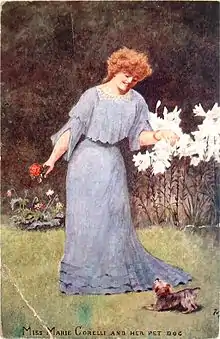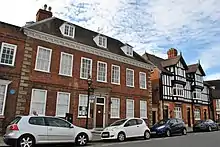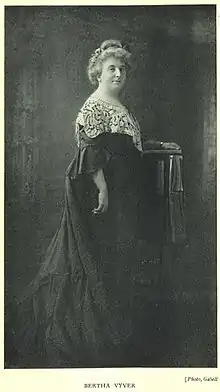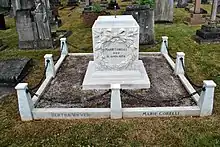Marie Corelli
Mary Mackay (1 May 1855 – 21 April 1924), known by her pseudonym Marie Corelli (/kəˈrɛli/,[1][2] also UK: /kɒˈ-/,[3] US: /kɔːˈ-, koʊˈ-/[3][4]), was an English novelist.
Marie Corelli | |
|---|---|
 | |
| Born | Mary Mackay 1 May 1855 London, England, United Kingdom of Great Britain and Ireland |
| Died | 21 April 1924 (aged 68) Stratford-upon-Avon, England, United Kingdom of Great Britain and Ireland |
| Occupation | Novelist |
| Nationality | British |
| Genre | Gothic, Fantasy, Scientific romance |
| Relatives | Charles Mackay (father) |
She enjoyed a period of great literary success from the publication of her first novel in 1886 until World War I. Sales of Corelli's novels exceeded the combined sales of popular contemporaries, including Arthur Conan Doyle, H. G. Wells, and Rudyard Kipling, although critics often derided her work as "the favourite of the common multitude".
Life and writings
Early life

Mary Mackay was born in London to Elizabeth Mills, a servant of the Scottish poet and songwriter Dr Charles Mackay, her biological father.[5] In 1866, eleven-year-old Mary was sent to a Parisian convent to further her education. She returned to Britain four years later in 1870.
Career
Mackay began her career as a musician, giving piano recitals and adopting the name Marie Corelli for her billing. Eventually she turned to writing and published her first novel, A Romance of Two Worlds, in 1886. In her time, she was the most widely read author of fiction. Her works were collected by Winston Churchill, Randolph Churchill, and members of the British Royal Family, among others.[6]
She faced criticism from the literary elite for her allegedly melodramatic writing. In The Spectator, Grant Allen called her "a woman of deplorable talent who imagined that she was a genius, and was accepted as a genius by a public to whose commonplace sentimentalities and prejudices she gave a glamorous setting."[7] James Agate represented her as combining "the imagination of a Poe with the style of an Ouida and the mentality of a nursemaid."[8][9]
A recurring theme in Corelli's books is her attempt to reconcile Christianity with reincarnation, astral projection, and other mystical ideas. She was associated at some point with the Fraternitas Rosae Crucis; a Rosicrucian and mystical organization,[10][11][12] and her books were a part of the foundation of today's corpus of esoteric philosophy. Her portrait was painted by Helen Donald-Smith.
Corelli famously had little time for the press. In 1902 she wrote to the editor of The Gentlewoman to complain that her name had been left out of a list of the guests in the Royal Enclosure at the Braemar Highland Gathering, saying she suspected this had been done intentionally. The editor replied that her name had indeed been left out intentionally, because of her own stated contempt for the press and for the snobbery of those wishing to appear in "news puffs" of society events. Both letters were published in full in the next issue.[13]
The writer also gained some fame after her letter on the curse of the Pharaohs to New York World was published. Corelli claimed that she had warned George Herbert, 5th Earl of Carnarvon (one of the finders of the tomb of Tutankhamun) about the "dire punishment" likely to occur to those who rifle Egyptian tombs, claiming to cite an ancient book that indicated that poisons had been left after burials.[14][15]
Personal life

Corelli spent her final years in Stratford-upon-Avon. There she fought hard for the preservation of Stratford's 17th-century buildings, and donated money to help their owners remove the plaster or brickwork that often covered their original timber-framed façades.[16] Novelist Barbara Comyns Carr mentions Corelli's guest appearance at an exhibition of Anglo-Saxon items found at Bidford-on-Avon in 1923.[17] Corelli's eccentricity became well known. She would boat on the Avon in a gondola, complete with a gondolier, whom she had brought over from Venice.[18] In his autobiography, Mark Twain, who had a deep dislike of Corelli, describes visiting her in Stratford and how the meeting changed his perception.

For over forty years, Corelli lived with her companion, Bertha Vyver,[19] to whom she left everything when she died. She did not identify herself as a lesbian, but several biographers and critics have noted the frequent erotic descriptions of female beauty that appear in her novels, although they are expressed by men.[20][21][22]
Corelli was known to have expressed a genuine passion for the artist Arthur Severn, to whom she wrote daily letters from 1906 to 1917. Severn was the son of Joseph Severn and close friend of John Ruskin. In 1910, she and Severn collaborated on The Devil's Motor, with Severn providing illustrations for Corelli's story. Her love for the long-married painter, her only known romantic attachment to a man, remained unrequited; in fact Severn often belittled Corelli's success.[23][24][25]
During the First World War, Corelli's personal reputation suffered when she was convicted of food hoarding.[26]

She died in Stratford and is buried there in the Evesham Road cemetery.[27] Later Bertha van der Vyver was buried alongside her.
Legacy
Corelli is generally accepted to have been the inspiration for at least two of E. F. Benson's characters in his Lucia series of six novels and a short story.[28] The main character, Emmeline "Lucia" Lucas, is a vain and snobbish woman of the upper middle class with an obsessive desire to be the leading light of her community, to associate with the nobility, and to see her name reported in the social columns, coupled with a comical pretension to education and musical talent, neither of which she possesses. She also pretends to be able to speak Italian, something Corelli was known to have done. Miss Susan Leg is a highly successful writer of pulp romances under the pseudonym Rudolph da Vinci. In E.F. Benson's "Secret Lives" a famous novelist Susan Leg, writes a book in which the heroine is another writer - Serena Lomond. This character is meant to be very similar to Susan herself, but in fact Serena Lomond is the spit of Mavis Clare in Marie Corelli's "The Sorrows of Satan". The character makes her appearance in Benson's work a few years after Marie Corelli's death in 1924.
A modern critic has written that Corelli was probably also the inspiration for "Rita's" (Eliza Humphreys's) main character in Diana of the Ephesians, which was published a year before E. F. Benson's first Lucia novel, and had been rejected by Hutchinson, which later published the "Lucia" Lucas novels.[29]
In Chapter III of Bruce Marshall's The World, the Flesh and Father Smith, the protagonist – a Catholic priest – is in hospital, recovering from a wound. A nurse gives him a copy of Marie Corelli's Temporal Power, with the hope that the book would convert him to Protestantism. However, Father Smith finds the book "stupid and flamboyant", puts it aside and prays for Corelli, since "she really ought to have known better".
In 2007, the British film Angel, based on a book by Elizabeth Taylor, was released as a thinly-veiled biography of Corelli. The film starred Romola Garai in the Corelli role and also starred Sam Neill and Charlotte Rampling. It was directed by François Ozon, who stated, "The character of Angel was inspired by Marie Corelli, a contemporary of Oscar Wilde and Queen Victoria's favourite writer. Corelli was one of the first writers to become a star, writing bestsellers for an adoring public. Today she has been largely forgotten, even in England."[30]
Works
| Library resources about Marie Corelli |
| By Marie Corelli |
|---|
Novels
- A Romance of Two Worlds (1886)
- Vendetta!; or, The Story of One Forgotten (1886)
- Thelma (1887)
- Ardath (1889)
- Wormwood: A Drama of Paris (1890)
- The Soul of Lilith (1892)
- Barabbas, A Dream of the World's Tragedy (1893)
- The Sorrows of Satan (1895)
- The Mighty Atom (1896)
- The Murder of Delicia (1896)
- Ziska: The Problem of a Wicked Soul (1897)
- Boy (1900)
- Jane (1900)
- The Master-Christian (1900)
- Temporal Power: a Study in Supremacy (1902)
- God's Good Man (1904)
- The Strange Visitation of Josiah McNasson: A Ghost Story (1904)
- Treasure of Heaven (1906)
- Holy Orders, The Tragedy of a Quiet Life (1908)
- Life Everlasting (1911)
- Innocent: Her Fancy and His Fact (1914)
- The Young Diana (1918)
- The Secret Power (1921)
- Love and the Philosopher (1923)
- Open Confession to a Man from a Woman (1925)
Short story collections
- Cameos: Short Stories (1895)
- The Song of Miriam & Other Stories (1898)
- A Christmas Greeting (1902)
- Delicia & Other Stories (1907)
- The Love of Long Ago, and Other Stories (1918)
Non-fiction
- The Modern Marriage Market (1898) (with others)
- Free Opinions Freely Expressed (1905)
- The Silver Domino; or, Side Whispers, Social & Literary (1892) (anonymous)
Film adaptations
- Vendetta (1915)
- Thelma (1916) Fox Film 1918, I.B. Davidson 1922 Chester Bennett
- Wormwood (1915) Fox Film
- Temporal Power (1916) G.B. Samuelson
- God's Good Man (1919) Stoll Films
- Holy Orders (1917) I.B. Davidson
- Innocent (1921) Stoll Films
- The Young Diana (1922) Paramount Pictures
- The Sorrows of Satan (1926) Paramount
Theatre adaptations
- Vendetta (2007) Adapted by Gillian Hiscott The Library Theatre Ltd; published by Jasper
- The Young Diana (2008) Gillian Hiscott; published by Jasper
References
Notes
- "Corelli, Marie". Lexico UK Dictionary. Oxford University Press. Retrieved 3 August 2019.
- "Corelli". Merriam-Webster Dictionary. Retrieved 3 August 2019.
- "Corelli". Collins English Dictionary. HarperCollins. Retrieved 3 August 2019.
- "Corelli". The American Heritage Dictionary of the English Language (5th ed.). Boston: Houghton Mifflin Harcourt. Retrieved 3 August 2019.
- Marie Corelli in Encyclopædia Britannica.
- Coates & Warren Bell (1969)
- Scott, p. 30.
- Scott, p. 263.
- Kirsten McLeod, introduction to Marie Corelli's Wormwood: a drama of Paris, p. 9
- Schrodter, Willy (April 1992). A Rosicrucian Notebook: The Secret Sciences Used by Members of the Order (illustrated ed.). Weiser Books, 1992. p. 293. ISBN 9780877287575. Retrieved 7 May 2017.
- "Who was Marie Corelli?". rosicrucian.50webs.com. Retrieved 7 May 2017.
- "Understanding reincarnation & esoteric teachings of Rosicrucians". The Rosicrucian Order, AMORC. Retrieved 7 May 2017.
- Ransom (2013), p. 100.
- The Shadow King: The Bizarre Afterlife of King Tut's Mummy, Jo Marchant, 2013, chapter 4. ISBN 0306821338
- [Ancient Egypt, David P. Silverman, p. 146, Oxford University Press US, 2003, ISBN 0-19-521952-X]
- The New York Times, 28 June 1903.
- Comyns Carr (1985), p. 124.
- Venice Boats.
- Frederico, pp. 162–86.
- Felski, pp. 130–31.
- Frederico, p. 116.
- Masters, p. 277.
- MacLeod, p. 21.
- Frederico, p. 144.
- Julia Kuehn, "Marie Corelli's Love Letters to Arthur Severn".
- "BBC One – Britain's Great War". BBC. 10 February 2014..
- Wilson, Scott. Resting Places: The Burial Sites of more than 14,000 Famous Persons, 3rd ed.: 2 (Kindle Location 9851). McFarland & Company, Inc., Publishers. Kindle Edition.
- Masters, Brian (1991). The Life of E.F. Benson. Chatto & Windus. pp. 237–238. ISBN 978-0701135669. Retrieved 1 November 2020.
- "Rita" The Forgotten Author. By Paul Jones L.R.P.S.
- "Interviews about Angel: François Ozon – Romola Garai – Michael Fassbender". François Ozon. Archived from the original on 3 April 2015. Retrieved 4 March 2015.
Sources
- Bleiler, Everett (1948). The Checklist of Fantastic Literature. Chicago: Shasta Publishers. pp. 85.
- Carr, Barbara Comyns, Sisters by a River (London: Eyre & Spottiswoode, 1947; new edition by Virago Press 1985)
- Coates, T. F. G. and R. S. Warren Bell. Marie Corelli: the Writer and the Woman. George W. Jacobs & Co.: Philadelphia, 1903. Reprinted 1969 by Health Research, Mokelume Hill, CA.
- Masters, Brian (1978). Now Barabbas was a rotter: the extraordinary life of Marie Corelli. London: H. Hamilton. p. 326.
- Felski, Rita (1995). The Gender of Modernity. Cambridge: Harvard U P. pp. 247.
- Frederico, Annette (2000). Idol of suburbia: Marie Corelli and late-Victorian literary culture. Charlottesville: University of Virginia Press. p. 201.
- Lyons, Martyn. 2011. Books: a living history. Los Angeles: J. Paul Getty Museum.
- Ransom, Teresa, The Mysterious Miss Marie Corelli: Queen of Victorian Bestsellers (2013)
- Scott, William Stuart, Marie Corelli: the story of a friendship (London: Hutchinson, 1955)
Bibliography
- Bigland, Eileen Marie Corelli, the woman and the legend: a biography, Jarrolds, London 1953
- Coates, T. F. G. and R. S. Warren Bell. Marie Corelli: the Writer and the Woman, George W. Jacobs & Co.: Philadelphia, 1903. Reprinted 1969 by Health Research, Mokelume Hill, CA.
- Federico, Annette R. Idol of Suburbia: Marie Corelli and Late-Victorian Literary Culture, University Press of Virginia, Charlottesville, 2000
- Masters, Brian Now Barabbas was a rotter: the extraordinary life of Marie Corelli, H. Hamilton, London, 1978
- Ransom, Teresa The Mysterious Miss Marie Corelli: Queen of Victorian Bestellers, Sutton, 1999
- Scott, William Stuart, Marie Corelli: the story of a friendship, London: Hutchinson, 1955
- Vyver, Bertha Memoirs of Marie Corelli, A. Rivers Ltd, 1930
- Ayres, Brenda; Maier, Sarah E. (Ed.): Reinventing Marie Corelli for the twenty-first century, London, UK ; New York, NY : Anthem Press, 2019, ISBN 978-1-78308-943-7
External links
| Wikisource has original works written by or about: Marie Corelli |
| Wikimedia Commons has media related to Marie Corelli. |
- Marie Corelli Collection at Yale University Music Library
- Marie Corelli at the Internet Speculative Fiction Database
- "Archival material relating to Marie Corelli". UK National Archives.

- Jessica Amanda Salmonson, Marie Corelli & her Occult Tales, 1998 (archived)
- Marie Corelli's Wormwood, excerpts (archived)
- Marie Corelli Collection. General Collection. Beinecke Rare Book and Manuscript Library, Yale University.
Online editions
- Works by Marie Corelli at Project Gutenberg
- Works by Marie Corelli at Faded Page (Canada)
- Works by or about Marie Corelli at Internet Archive
- Works by Marie Corelli at LibriVox (public domain audiobooks)
